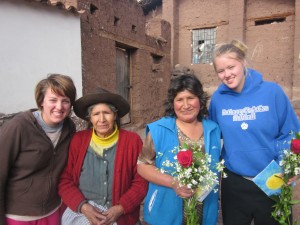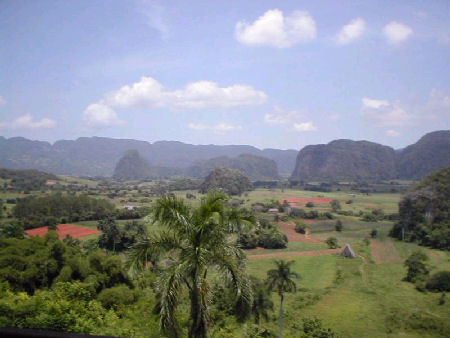On the second Sunday of May the Day of the Mothers is celebrated in a great part of the world. In some countries it calls itself Day of the Mother to this holiday, but in all it has the same meaning. Although it is a question of a love that is evident or must be evident during the whole year, in this occasion a special moment is assigned to honor them. When this chronicler was a child, we all in this day were going out to the street taking a red or white carnation, as we had the living or dead mother. The men, in the revers and the women, in the blouse. These carnations, at least in Cuba, stopped being seen in the last decades and passed to a few postcards with allegorical motives that the recipient receives punctually in the date. The love follows the mother being evident and, beyond the proper mother, one extends all the women that we love or whom gratitude bonds join to us, have children or not. It is like another Day of the Woman, but more intimate. In the previous days, the shops do its August since nobody wants to honor its progenitora with the empty hands, although to her the alone gift is enough a kiss to her. And those who have her dead, come to the cemetery. In this date, the flowers become exhausted, the restaurants become saturated, there is carried out finally that visit always postponed to the old and distant aunt and the transport becomes unbearable.
The celebration of Mother’s Day originated in the United States. The North American Anna Jarvis created in Philadelphia an association to impel it. To the beginning, the new organization scarcely was warned and its intention, ignored, but it did not spend a lot of time so that any partial successes were already noted down since in 1914 several states of the Union, following its recommendations, they did local holiday the day and the House of Representatives recommended that to be observed by the members of two co-legislative bodies of the Congress, as well as for the first chief of the nation. In three or four more years the initiative was generalized in the United States and began making way for him in the face of the world.
It came much early to Cuba. And here there becomes essential the mention of that protein and tireless journalist who was Víctor Muñoz, because he pleaded before nobody because the Day of the Mothers began to be celebrated in the Island. It did it in its column “Along with The Acropolis” that, with the Attaché’s pseudonym, The World was publishing in the newspaper, of Havana. It titled to this page “My white carnation”.
Muñoz was a proprietor of an extraordinary humorous seam and he was reviewing the baseball games between Cuba and the United States like a competition in which the nascent Republic was justifying its right to life. It was encouraging in its comments the Cuban victory as a question of national sovereignty.
Under the pseudonym of ‘Frangipane’, Muñoz was the creator of the Cuban sports page. His column “The Week” in the Sunday edition of El Mundo, was leidísima, as already alluded to “Along the Capitol”.
The Capitol along with which Víctor Muñoz was writing was supposedly that of Washington. The readership believed that before that page so lucid and spontaneous, full of novel information that seemed written from the shores of the Potomac. In fact, the chronicler, with the help of the cable and of the North American publications that it was collecting, he was writing its section in the proper writing of The World. There, bearing in mind its excessive corpulence that was making it sweat to seas, the director of the newspaper had arranged for him a private room, he was located in the roof, where Víctor Muñoz was doing its work in briefs.
The idea of Muñoz did not fall down in the gap and already in 1920 impelled by a group of young people with social and intellectual worries, the Day of the Mothers was celebrated in Cuba for the first time. It was in Santiago de las Vegas, city of the south of the Cuban capital.
Months later, in the elections of November 1, 1920, Muñoz was an elect councilman for the Town hall of Havana, and in this Chamber, the newly released town councilor proposed, on April 22, 1921, that the holiday to be instituted in the municipality of Havana. It is not until 1928 when the House of Representatives, at the proposal of Pastor del Río, approves, with law character, its national celebration.
Víctor Muñoz had already died, in 1922.
Sources: CiroBianchiRoss / InternetPhotos / www.thecubanhistory.com
Mother’s Day / Dia de las Madres
The Cuban History, Arnoldo Varona, Editor
EL DIA DE LAS MADRES
El segundo domingo de mayo se celebra en buena parte del mundo el Día de las Madres. En algunos países se llama Día de la Madre a esa fiesta, pero en todos tiene el mismo significado. Aunque se trata de un amor que se manifiesta o debe manifestarse durante todo el año, en esa ocasión se destina un momento especial para honrarlas. Cuando este cronista era niño, todos en esa jornada salíamos a la calle llevando un clavel rojo o blanco, según tuviésemos a la madre viva o muerta. Los hombres, en la solapa y las mujeres, en la blusa. Esos claveles, al menos en Cuba, dejaron de verse en las últimas décadas y dieron paso a unas tarjetas postales con motivos alegóricos que la destinataria recibe puntualmente en la fecha.
El amor a la madre sigue manifestándose y, más allá de la madre propia, se extiende a todas las mujeres que amamos o a las que nos unen lazos de gratitud, tengan hijos o no. Es como otro Día de la Mujer, pero más íntimo. En los días previos, las tiendas hacen su agosto pues nadie quiere homenajear a su progenitora con las manos vacías, aunque a ella le baste el regalo solo un beso. Y los que la tienen muerta, acuden al cementerio. En esa fecha, las flores se agotan, se abarrotan los restaurantes, se lleva a cabo al fin aquella visita siempre pospuesta a la tía vieja y lejana y el transporte se hace insufrible.
La celebración del Día de las Madres surgió en Estados Unidos. La norteamericana Anna Jarvis creó en Filadelfia una asociación para impulsarla. Al comienzo, la nueva organización apenas fue advertida y su propósito, ignorado, pero no pasó mucho tiempo para que se anotara algunos éxitos parciales pues ya en 1914 varios estados de la Unión, siguiendo sus recomendaciones, hicieron fiesta local el día y la Cámara de Representantes recomendó que fuera observado por los miembros de los dos cuerpos colegisladores del Congreso, así como por el primer mandatario de la nación. En tres o cuatro años más la iniciativa se generalizó en Estados Unidos y empezó a abrirse paso en la faz del mundo.
Llegó muy temprano a Cuba. Y aquí se hace imprescindible la mención de aquel periodista proteico e incansable que fue Víctor Muñoz, porque él abogó antes que nadie porque el Día de las Madres comenzara a celebrarse en la Isla. Lo hizo en su columna “Junto al Capitolio” que, con el seudónimo de Attaché, publicaba en el periódico El Mundo, de La Habana. Tituló a esa página “Mi clavel blanco”.
Muñoz era dueño de una veta humorística extraordinaria y reseñaba los juegos de béisbol entre Cuba y Estados Unidos como una competición en que la naciente República justificaba su derecho a la vida. Alentaba en sus comentarios el triunfo cubano como una cuestión de soberanía nacional.
Con el seudónimo de Frangipane, Muñoz fue el creador de la crónica deportiva cubana. Su columna “La Semana” en la edición dominical de El Mundo, fue leidísima, al igual que ya aludida “Junto al Capitolio”.
El Capitolio junto al cual escribía Víctor Muñoz era supuestamente el de Washington. Eso creían los lectores ante aquella página tan lúcida y espontánea, llena de informaciones novedosas que parecía escrita desde las orillas del Potomac. En realidad, el cronista, con la ayuda del cable y de las publicaciones norteamericanas que allegaba, escribía su sección en la propia redacción de El Mundo. Allí, en atención a su gordura desmedida que lo hacía sudar a mares, el director del diario había dispuesto para él una habitación privada, ubicaba en la azotea, donde Víctor Muñoz hacía su trabajo en calzoncillos.
La idea de Muñoz no cayó en el vacío y ya en 1920, impulsado por un grupo de jóvenes con inquietudes sociales e intelectuales, se celebraba en Cuba por primera vez el Día de las Madres. Fue en Santiago de las Vegas, ciudad del sur de la capital cubana.
Meses más tarde, en las elecciones del 1 de noviembre de 1920, Muñoz fue electo concejal por el Ayuntamiento de La Habana, y en esa Cámara, el recién estrenado edil propuso, el 22 de abril de 1921, que la fiesta se instituyera en el municipio habanero. No es hasta 1928 cuando la Cámara de Representantes, a propuesta de Pastor del Río, aprueba, con carácter de ley, su celebración nacional.
Ya Víctor Muñoz había muerto, en 1922.
Sources:CiroBianchiRoss/InternetPhotos/www.thecubanhistory.com
Mother’s Day / Dia de las Madres
The Cuban History, Arnoldo Varona, Editor







